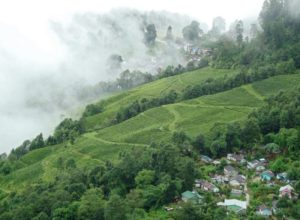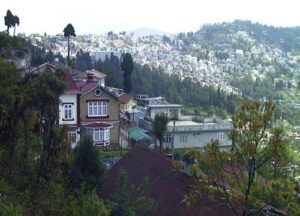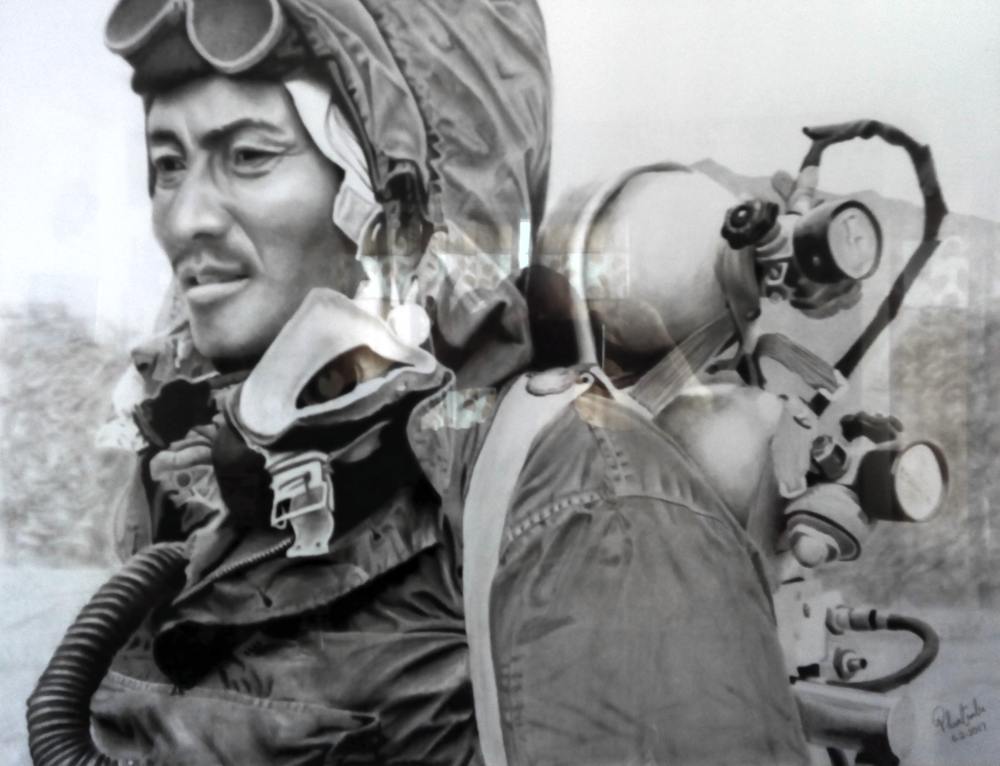Yes – there is a place called Darjeeling. And yes, it’s the same Darjeeling as the well known English black tea. The name even sounds strangely English.
But what’s especially thrilling about Darjeeling is it’s relationship to Mt. Everest and the late Tenzing Norgay, above, who was the very first human to set foot on the summit. As the story goes, Sir Edmund Hillary had such respect for Norgay that he stepped aside to allow his friend the honor of being the first on the summit. After that, many other climbing expeditions to Everest were staged from here. And just down the road from where I stayed was the past home of Tenzing Norgay himself. I came to Darjeeling to catch a glimpse of the world’s third highest mountain, Kanchenjunga, a less famous but massive glacier peak in the nearby Himalayas. I also came to cool off after several months in the South of India and a quick stop in sweltering Calcutta (now Kolkata). Thirdly, I picked Darjeeling as my first stop in an informal tour of the state of Sikkim, the clean “organic” state of India.
To get to Darjeeling, plan to get stuffed inside a dusty jeep with nine other people and their luggage. Begin your three-hour jeep ride from Siliguri, a town that is accessible by train from all parts of greater India. As my jeep bounced along, I was impressed by the endless winding uphill climb from the humid plain below, and by the vegetation that seemed to get greener and greener as we gained altitude.
The historical town of Darjeeling waits for you atop a group of steep mountains in the state of West Bengal in the North of India. At 7,000 feet above sea level, the misty clouds definitely keep one cool and moist. Since the summer monsoon season was still in effect during my visit, every day brought fog and/or rain. That moisture was great for tea cultivation but not for tourism. I wanted grand mountain views, not chilly clouds.
 By a stroke of good luck, I met a charming Nepali mountain guide by the name of Palzer. Nepali? Yes, that’s because in these parts we are tucked in between Nepal to the west, and Bhutan to the east. Over past centuries, as kingdoms and national boundaries change, ethnic identities and languages move and change as though they have a life of their own. Here, over half the population speak Nepali and claim family ties to Nepal.
By a stroke of good luck, I met a charming Nepali mountain guide by the name of Palzer. Nepali? Yes, that’s because in these parts we are tucked in between Nepal to the west, and Bhutan to the east. Over past centuries, as kingdoms and national boundaries change, ethnic identities and languages move and change as though they have a life of their own. Here, over half the population speak Nepali and claim family ties to Nepal.
Palzer invited me to stay at his guest house which was walking distance from the tiny restaurant where we met. I accepted.
Before coming to Darjeeling, I expected to see vast tea plantations. Instead, I spent my few days in the hilly and congested town. Narrow streets and the major influx of Indian tourists ensure that vehicles move at a crawl. To offset this annoyance, as I muscled up the steep streets and staircases, I knew that my legs were rapidly gaining strength. (No more feelings of discomfort over missed trips to the gym.)
Palzer’s guest house was located about a kilometer’s walk down a rutted muddy road along a steep mountain ridge a bit removed from the town. From his terrace I enjoyed a beautiful view of the vast green valley below and the adjacent Himalayan mountain ridge that I judged to be about a mile away as the crow flies.
Hmmmm….. What is that strange sound, and where is it coming from? It was coming from a typical three-story house within view of our terrace. I discovered that a group of 20 Tibetan Buddhist monks in their red robes were conducting a special ceremony or “puja” to bless the house. I could see them. Over the course of three days one could hear their characteristic Tibetan instruments as well as chanting. The bells, horns, brass cymbals, and drums added an exotic mood to Palzer’s terrace.
I walked toward the house to get a closer look. The gentleman who owned the house beckoned me to come inside. After all, a white Westerner is usually regarded as somebody special and something to get excited about. I entered the gate and made my way upstairs, asking first about the shoe protocol. He said “no no” it was okay to wear my shoes rather than leave them at the door.
Once upstairs with the monks, I enjoyed their special sounds from up close. The long metallic Tibetan horn sounded exactly like a wooden Australian didgeridoo. Soon the instrumental performance was done and the monks sat at a long breakfast table. The owner showed me his specially outfitted upper room, his puja room, that looked exactly like the colorful sanctuary at any Tibetan monastery. Upon leaving, I made a point of reaching out to the monks – everybody in the world understands a smile and a wave. They happily waved back.
I was happy to meet Palzer, not only because I got to stay in his affordable guest house, but also because he had many stories to tell from his previous life as a professional mountain guide. He led both climbing and trekking parties for many years. He knew the business well, was physically tough, and spoke excellent English. His friendly, confident manner seemed perfect for guiding and assisting Western people who want to have breathtaking experiences in the Himalayas. Due to family responsibilities, he now had to stay closer to home. Therefore, his guest-house business had become his primary focus.

After a few days in Darjeeling, I made plans to continue my exploration of the Indian state of Sikkim. As a foreigner, it was necessary for me to obtain a special 14-day permit to enter Sikkim. Why? Unlike the rest of India, Sikkim is free of chemical pollution and ugly trash. The non-corrupt government of Sikkim aims to keep it that way. Therefore, they have instituted tight controls on who can visit and who can purchase property in the state.
While I did not go trekking or climbing in Sikkim due to time constrains, I found a land of steep mountains blanketed by dense jungle. Having grown up in the Pacific NW, I am accustomed to mountains covered by forests of tall Douglas Fir and Pine. Here the mountains are covered by thick broad-leaf vegetation that can only be described as jungle. Interesting. Why jungle? It’s the rainfall and temperature.
After this visit to India’s tea region, I will forever have a changed viewpoint when enjoying a hot cup of Darjeeling tea.

